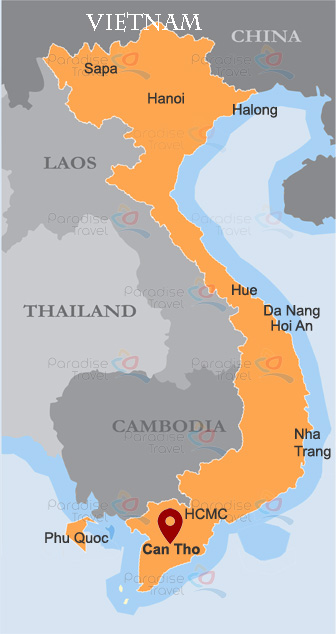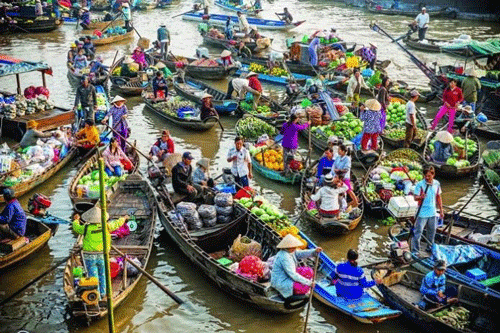Can Tho Travel Guide
 General Information
General Information
Can Tho is a unique city in the Mekong Delta, along with other provinces it’s famous for its rice harvest output of 1000 tons/year. Located in the middle – downstream and central of the Mekong Delta, on the South bank of Hau river, Can Tho is known as a buzzing town with a lively waterfront lined sculpted gardens, a beautiful combination of narrow backstreets and wide avenues, and perhaps the biggest gathering of foreigners in the delta. It is also the idea factor for floating markets with many bustling activities. Besides, tourists are surely attracted by ancient houses, the orchards full of delicious tropical fruits, charming traditional music. Taking a boat tour alongside the various sites will not disappoint any visitors on a tour to Northern Vietnam.
Be bordered by An Giang province to the north, Dong Thap province to the east, with Kien Giang province to the west and with Hau Giang province to the south, Can Tho is the largest city in the region, covering an area of 1,409 square kilometers and be home to 1,214,100 people as of 2012 and feels like ‘western capital’ after a few days exploring the backwaters. The city of Can Tho is divided into nine districts: Ninh Kieu, Binh Thuy, Cai Rang, O Mon, Thot Not, Phong Dien district, Co Do, Vinh Thanh, Thoi Lai District. The city is the homeland of some ethnic groups, including the Vietnamese, the Chinese, Khmer.
Can Tho Weather
Can Tho weather is divided into two different seasons: dry season and rainy season. In dry seasons, Can Tho climate is portrayed by low humidity and rainfall; the temperature ranges from 23-30 degrees Celcius. In rainy seasons, Can Tho weather witnesses a change in rainfall level starting from May.

- Weather in Can Tho
What to See in Can Tho
Cai Rang Floating Market

- Cai Rang Floating Market
The market is the main biggest wholesale floating market near Can Tho where hundreds of boats carrying much of goods exchange throughout the area every day. The boats are laden with fresh fruit and vegetables. A variety of colors come from fruit, vegetables, traders, tourists creates a large stunning painting across the green murky waters. To join in the market, tourists should go there early in the morning (as early as 5:30 am), and come back through the small tributaries to Can Tho river about 3-4 hours.
Make sure that you book a small boat at Ninh Kieu pier or from local tour agents to go through the small canals where the big ones cannot navigate. Prices are negotiable and depend on the length of Mekong Delta daily tours.
Can Tho Fruit Garden Tour

- Entrance of My Khanh Fruit Orchard
Like other Western provinces, Can Tho attracts tourists by a large number of orchards. Visiting some orchards when traveling to Vietnam, tourists not only have a chance of contemplating a rich collection of fruit trees, flowers and diverse species of birds, fishes, etc. but also are allowed to try these local specialties. In recent years, more and more modern tourism gardens have appeared on every land and water routes such as My Khanh Ecotourism, Garden of Mr. Duong, Bich Thuy orchid garden, garden arch on the rivers Phong Dien river, Phung Hiep river and many other family tours in O Mon and Thot Not.
Bang Lang Stork Sanctuary

- Bang Lang Stork Sanctuary
Pay a visit to Bang Lang stork sanctuary, tourists stands a golden chance to discover one of the most attractive tourist destinations in the Mekong Delta with thousands of storks returning home in the late afternoon after a hard whole day seeking food from other places.
Located in Thot Not district, there are more than 300,000 storks of nearly 20 varieties reside in the sanctuary. You can watch the storks from a distance or from a bird’s eye-view because they are sensitive to strangers.
Pagodas and Temples
Can Tho is the place of a lot of historical and beautiful pagodas and temples:

- Binh Thuy Old House
- Binh Thuy Old House: Bui Huu Nghia street, Binh Thuy Ward, Binh Thuy District

- Ong Pagoda
- Ong Pagoda: Hai Ba Trung Street, Tan An Ward, Ninh Kieu district

- Nam Nha Pagoda
- Nam Nha Pagoda: 612 Cach Mang Thang 8, An Thoi Ward, Binh Thuy District

- Pitu Khosa Rangsey Khmer Pagoda
- Pitu Khosa Rangsey Khmer Pagoda: 27/2 Truong Dinh Street, Ninh Kieu District
Tay Do Night Market
Going 1km from the center of Can Tho City to the west of Hau River, tourists will see Tay Do Market, which is not only the trading place of Southern provinces but also the cultural tourist destination features, highlights, and attractions in Can Tho.

- Tay Do Night Market
The architecture of market carries the distinct special feature of Southern style and harmonizes with the landscape around. There are a lot of booths inside the market with the spacious cemented paths in the middle makes an airy and artistic space. Tourists can have a variety of buying choices when coming here.
Ninh Kieu Park

- Ninh Kieu Pier
Ninh Kieu park is a port and a long-lasting and attractive tourist destination of Can Tho City which was built in the 19th century and are famous for beautiful poetic landscape and exciting atmosphere. For many years, this park has become the everlasting inspiration of many poets and a ‘magnet’ that attracts a large number of tourists every year.
What to Eat in Can Tho
1. Banh xeo (Vietnamese Pancake)

- Banh xeo
Banh xeo is the popular food street in Can Tho which can be found everywhere, from the street stalls or luxurious restaurants. The word xeo depicts the sizzling sound when pouring the rice batter into the hot skillet.
The cake has a yellow outer layer containing boiled pork strips, shrimp, bean sprouts and spring onion. To enjoy it, firstly, cut the cakes into small pieces, then take a piece of it and roll tightly into a rice paper with served vegetables, dip the roll into the sauce and taste it. To have the best taste, it is highly recommended to use your hands, not the chopsticks.
2. Chuoi Nep Nuong (Baked Sticky Rice Banana Bun)

- Chuoi nep nuong
In Can Tho, the banana buns are small and sweet, which is the ideal choice for a snack or dessert. Bananas are covered in a layer of glutinous sticky rice which has been cooked in coconut milk. A banana leaf is wrapped around the center of the banana and rice package and then it is placed to grill.
3. Grilled Green Pepper Snails
Steam the snails and grill them on the charcoal. The dish will be more delicious when it is served with the suitable sauce consisting of fish sauce, pepper, and garlic.
4. Vietnamese Noodles in Coconut Cream (Banh tam bi)

- Banh tam bi
This food is a southern Vietnamese dish of thick rice and tapioca noodles, tossed with herbs and pork and drenched in thick coconut cream dressing. You will not be able to try this food taste anywhere else as it is unique and special.
5. Salt Fried Rock Crab
By motorbike, drive in 10 minutes to Dinh Tien Hoang Street near Hung Vuong Bus Station to have a chance to try the best rock crab ever.
The rock crab’s size is as big as an expanding adult hand with purple shells and pincers and its shape is like the paddy field crab. Calling rock is due to the fact that the crab usually lives in rocky area, reef of the island or the rock cliff of the South coast. Their meat is white, soft and sweet, which is perfect for the salt-n-pepper lemon mix.
Location:
Can Tho is located 169 kilometres (105 miles) from Ho Chi Minh City in southern Vietnam’s Mekong Delta region.
Area: 1,409 km²
Weather:
Can Tho’s climate is tropical with two seasons: rainy (from May to November) and dry (from December to April). Average annual humidity is 83%, rainfall 1,635 mm (64 in) and temperature 27 °C (81 °F).
How to get there:
The best way to get to Can Tho from Ho Chi Minh City is by bus service. There are 2 main bus companies serving the Mekong Region, such as Phuong Trang and Thanh Buoi. A one-way ticket costs 110,000 dong (approximately $5.50).
Highlights:
Can Tho is the political, economic, cultural and transportation centre of the Mekong Delta. It is also the largest city in the region which is connected to most other population centres in the Mekong Delta by a system of rivers and canals. These waterways and the colorful Cai Rang Floating Marke draw interest of tourists coming to Vietnam.
In the heart of Mekong River Delta, Can Tho located in an intricate network of rivers, brooks, canals and ditches, which provide the main source of transportation for many areas in the province. These waterways also feature banks shaded by coconut and palm trees, delicate “monkey bridges” and numerous intriguing floating villages and markets.
In the past, Can Tho was given the title Tay Do (Capital of the Western Provinces), and it remains the “rice basket” of southwestern Vietnam today. In addition to being a major rice producer, the province is also known for its abundant fruit orchards, freshwater aquaculture, and lush, quintessentially Vietnamese rural scenery.
What to do? |
The most interesting thing to do in Can Tho is take a boat ride through canals and visit Cai Rang Floating Market.
Outside of the town is the stork garden at Thot Not where hundreds of egrets, herons and cormorants gather in the treetops to roost late in the afternoon. Can Tho is usually combined with the trip to Chau Doc, a little town near Cambodian border.
When to go? |
Trips to Mekong Delta are suitable all year round but the best time is the monsoon from June to September.
Travel Tips |
Bring along camera, hat, sunscreen and insect repellant. Should keep your camera in a plastic bag when it is not in use as it is easy to get splashed by the wake of motorized boats.

 General Information
General Information











